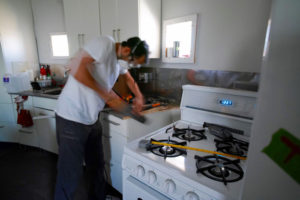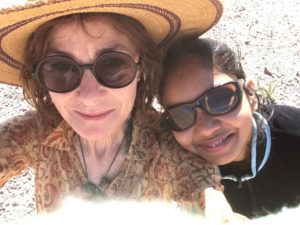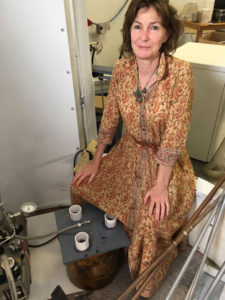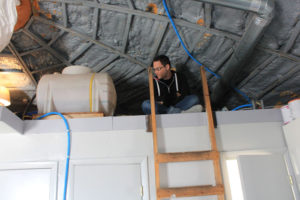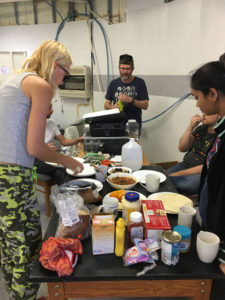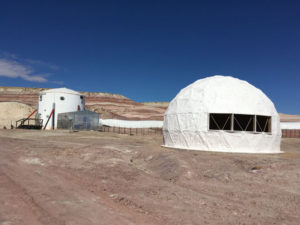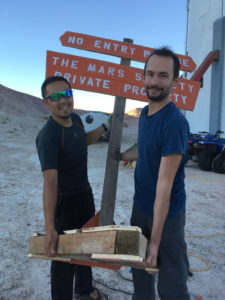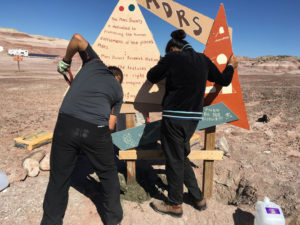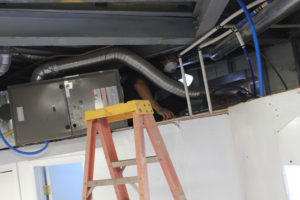Jon Clarke submitted these Journalist reports while Anastasiya was out…
Report 26th September
The third day of our expedition saw our on-going work on making MDRS ready for our simulation. We experienced the pleasures familiar to home renovators everywhere, eating, sleeping, and living in the middle of a work in progress. Filling, painting, pulling out old appliances, installing new ones, stretching tarpaulins over the tunnel frames, or sourcing unexpected but needed items from local suppliers. All the while getting to know each other better, entertaining unexpected visitors, and planning our future activities when the full simulation starts. All this activity raises important questions for future Mars residents. MDRS is 15 years old, and needs all this work. How is this work to be carried out on Mars. How is the obsolete equipment, or surplus structural materials to be disposed off? Should they just be dumped outside the station? Should be the recycled? How do you recycle items made from hundreds components using thousands of different materials? These problems are familiar to anyone working in remote areas on Earth, in mountains, deserts, and the poles, we will have them on Mars. There will be additional ones as well, perhaps even unexpected issues, forced on us by the constraints of launch windows, time, communications, mass, and distance. Meanwhile, here on Earth we are learning the importance of adaptability. Our engineers, Alexandre and Clauche-Michell, sorting out internet problems and non-compatible gas fittings, Anastaysia, our journalist, working with our architecture Yusuke, to stretch tarpaulins over the tunnels connecting the different modules of the station. Annalea our artist has been digging holes and sign writing, to inform our many visitors. Jon, the crew geologist, has been painting the walls. Shannon, our PI and backup crew member, has been supervising us from her enormous expertise and knowledge of MDRS from her many years experience at MDRS. What’s on the program for us tomorrow? More of the same! But we hope to be joined by our final crew member, Anushree from India, our crew biologist
Report 28th September
We, the M160 crew, gold the following truth as self evident: The Hab is not self cleaning! Like many self evident truths, it may not be evident to all. So here is a snippet of our day. Most of the heavy painting and repair work has been done, but there is still a great deal of cleaning to be done. A lot of the cleaning is only possible because a lot of the old fittings have been stripped out. Sweeping, vacuuming, mopping, scrubbing the steel deck by hand have been part of the days program since soon after sun up to after dark. We concreted a public information sign in place near the turn-off on the main access road, the romantically named “Cow Dung Road”, this was put up previous, but had blown over. Six bags of quickset cement and a dozen large rocks should help. We are still without a working stove, so are also coping with the challenge of cooking for seven with one small microwave and two microwave pots. At least the shower water is hot!
As with all the modifications and updates, all of this work is very relevant to help us understand what the experience of living on Mars will be like. Over the years of occupation a Mars settlement will need cleaning. Complete exclusion of the martian environment is likely to be impossible, so this means that dirt will be tracked in side and build up if not removed. Filters will have to be cleaned, fabrics (and human bodies) will shed, spillages in kitchens, workshops, labs, and food growing and processing areas will all contribute their share. It may not be the romance of space travel or Mars settlement but, as with how to manage renovations and modifications and the waste that results, it is a reality in any analogue facility or any kind of remote living on Earth. It will be the same on Mars. How many Mars settlement plans, not matter how grandiose, deal with the issue of housework, and who does it? At least the crew of M160 are all cheerfully working together to get the dirty work done as quickly and efficiently as possible! Then there is the question of what cleaning materials can be used in a closed or semi-closed systems and how you deal with them after use. Can they be recycled or are they toxic waste that has to be disposed of without contaminating the habitat or the martian environment?
The M160 program allows us to think of these questions and identify some of the key issues, even when we can’t specifically solve them. We are laying the groundwork for more detailed and targeted research that will.
